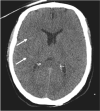Neuronal desertification after a direct lightning strike: a case report
- PMID: 36271452
- PMCID: PMC9585841
- DOI: 10.1186/s13256-022-03500-w
Neuronal desertification after a direct lightning strike: a case report
Abstract
Background: Lightning strike is a rare but dramatic cause of injury. Patients admitted to intensive care units (ICUs) with lightning strike frequently have a high mortality and significant long-term morbidity related to a direct brain injury or induced cardiac arrest (CA).
Case presentation: A 50-year-old Caucasian man was admitted to our hospital after being struck by lightning resulting in immediate CA. Spontaneous circulation was initially restored, and the man was admitted to the ICU, but ultimately died while in hospital due to neurological injury. The computer tomography scan revealed a massive loss of grey-white matter differentiation at the fronto-temporal lobes bilaterally. Somatosensory-evoked potentials demonstrated bilateral absence of the cortical somatosensory N20-potential, and the electroencephalogram recorded minimal cerebral electrical activity. The patient died on day 10 and a post-mortem study revealed a widespread loss of neurons.
Conclusion: This case study illustrates severe brain injury caused by a direct lighting strike, with the patient presenting an extraordinary microscopic pattern of neuronal desertification.
Keywords: Brain injury; Cardiac arrest; Hypoxic ischaemic brain injury; Lightning strike; Neuronal desertification.
© 2022. The Author(s).
Conflict of interest statement
The authors declare they have no competing interest
Figures





References
-
- Zafren K, Durrer B, Herry JP, Brugger H. Lightning injuries: prevention and on-site treatment in mountains and remote areas. Official guidelines of the International Commission for Mountain Emergency Medicine and the Medical Commission of the International Mountaineering and Climbing Federation (ICAR and UIAA MEDCOM) Resuscitation. 2005;65:369–372. doi: 10.1016/j.resuscitation.2004.12.014. - DOI - PubMed
-
- Centers for Disease Control and Prevention (CDC) Lightning-associated injuries and deaths among military personnel—United States, 1998–2001. MMWR Morb Mortal Wkly Rep. 2002;51:859–862. - PubMed

